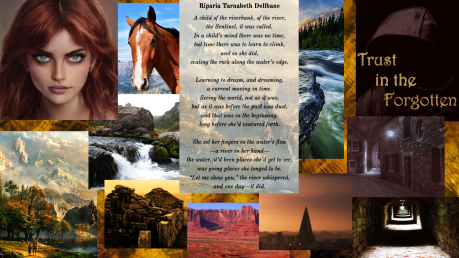Another episode of Christina’s quirky compulsions…
I have a strong conceptual approach to all my creative endeavors. I’m sharing this because some of my approaches are actually accepted elements in good writing, but not all. This is a bit abstract so I hope I can explain it.
I’m no psychologist, but I’m an INFJ personality type and they’re close to the same thing. Kidding. Mostly. Maybe that explains this proclivity.
I see stories visually, and I don’t mean what’s conveyed via the words. I also see all the components, how they fit together, and how they appear. That means, like a good little writer, it’s easy for me to vary my sentence lengths. This compulsion also extends to paragraph and chapter lengths. It isn’t just about numbers … I see them.
I’m doing it right now.
And now you’re laughing. Or maybe you’re thinking, Huh?
It goes much deeper than what I’ve described, but maybe a simple example will help. If you read a story I’ve written you’ll not find monstrously long paragraphs, one after the other. I want variance and white space, for me, and to make reading easier for the reader. Ever try to fill out a confusing, crowded form?

Vinyl album where each track is visible. Distance or closeness to the center does also influence width a little. Courtesy: Pixabay
It’s like that.
In my blog posts, I vary paragraphs, but also kinds of paragraphs, adding lists and quotes if possible, not to mention pictures.
Even still my explanation is inadequate, so let’s go back to when I first became aware of the compulsion, back to records, to vinyl. I love my digital music, but vinyl LPs had a unique aspect. You could see where songs began and ended, creating a pattern. If there was track length variance?
Oh how excited I’d become.
Awareness came with my much older sister purchasing Sgt. Pepper’s Lonely Hearts Club Band (1967) by the Beatles. Here’s side two: long song, 3 short songs, a brief reprise, and another long song.
Sweet mother of all! A visual representation of the tracks.
Now, we go deeper…
Sgt. Pepper was also my introduction to the concept album, though the concept isn’t a strict one. Instead, it’s a lyrically loose concept held together by a strong musical concept. The strong musical concept, I attribute, in part, to their producer, George Martin. Abbey Road (1969) is a good example, an album that sounds like a concept album, but isn’t.
My musical tastes are fairly eclectic, and I don’t need the above to enjoy music, but my favorite albums are typically conceptual in one or more ways. Here’s a sampling:
- To Our Children’s Children’s Children (1969) Moody Blues
- Wish You Were Here (1975) Pink Floyd
- I Robot (1977) The Alan Parsons Project
- Autoamerican (1980) Blondie
- Shepard Moons (1991) Enya
- The Book of Secrets (1997) Loreena Mckennitt
- La Luna (2000) Sarah Brightman
- LOTR Soundtrack (2001-03)
- An Ancient Muse (2006) Loreena McKennitt
- My Winter Storm (2008) Tarja
- Dreamchaser (2013) Sarah Brightman
It’s no coincidence these are frequent choices for while writing, which brings me back around to story.
I read Lord of the Rings the same year Wish You Were Here came out, forever linking them in my mind. Meanwhile, The Book of Secrets helped inspire my Ontyre worldbuilding and first fantasy novel, drafted while the LOTR soundtrack/movies were released.
Etherial Dreamchaser remains beloved. All of Sarah Brightman’s albums are concept albums (I’m a HUGE fan). Too, in an interview, she cited the concept albums of the 60’s and 70’s as inspiration.
So, I vary sentences and paragraphs, but also chapters. Story rules, of course, but I’m always mindful of the visual representation they create. I also note sequences. For instance, Trust in the Forgotten opens with the chapters chronicling the night that changed Riparia’s life. While editing, I identify a chapter’s keyword that sums up its tone. That influences word choices.
Now for the macro.
I’m conscious of where each novel falls in the overall series, which is what inspired this post in the first place. I’m currently creating the revision map for Book6, Aramon Daughters, which contains the Kovenlore Chronicles’ third plot point and dark night of the soul.
The novel is off kilter and sometimes disturbing (by my standards). There’s less humor and it chronicles a character’s downward spiral. One setting is the library, Sa’kōtōs Mynos, located at the end of the way that isn’t there. It’s a labyrinth with books and is interactive in unsettling ways.

Trust in the Forgotten mood board Troubling events are clustered to the right. The water images are linked by the poem. There’s also Riparia’s horse, Doppla. Mood board: CA Hawthorne. Images: Pixabay, except for Riparia, her image created in Artbreeder by CA Hawthorne.
I’m always examining arrangements, concepts, format, tone, theme. Without it, for me, a story is incomplete. It also manifests as foreshadowing, of course, but also as me resurrecting earlier events to twist them anew.
I’m not, though, a fan of flashbacks most of the time.
Trust in the Forgotten is an example. The opening scene (heck, the opening paragraph) foreshadows a pivotal moment later in the novel, but also foreshadows a critical moment in Aramon Daughters that, in turn, returns a character to an important moment from Trust. On and on it goes. If a reader misses a lot of this there’s no harm done, but if they start to notice, it’ll enrich the experience.
On the other hand, after Riparia’s visit to the Library of Thoughts it’s pretty difficult to miss.



It’s always a challenge in writing: translating the shapes and patterns in the mind into a linear chain of words. And then trying to craft that linear chain in ways that (hopefully) will then create shapes and patterns in the mind of the reader. It’s true for non-fiction also, which is about meaning as much as it is about simply listing data. The frustration – at least for me, as a mostly non-fiction writer just now – is when readers miss the whole intent, simply looking at the data I have used to support the meaning; or latching on to a word they decide is ‘wrong’ and using it as a device to discredit the whole work.
At a certain point we can’t control the receiving end of communication. Everyone arrives with their own baggage, some with their own agenda. That’s fine, until the opinion is shared. It’s a hazard, though I’d imagine it’s a greater hazard for those who write non-fiction.
On my experience, non-fiction is definitely the riskier and, absolutely, people arrive laden with both baggage and agenda. (Curiously, I just blogged on the risks today!).